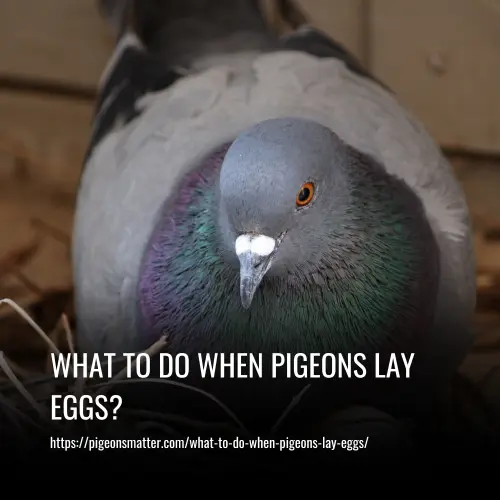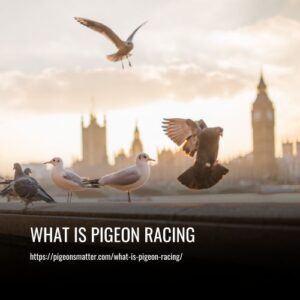Racing pigeons, also known as homing pigeons, are bred for their remarkable speed and keen sense of direction. These birds can fly up to 70 miles per hour and navigate long distances using their ability to detect magnetic fields. Pigeon fanciers take great care when breeding pairs to create the most successful racers possible.
Racing events vary depending on the type of pigeon and the country in which it is being raced. Loft and club races are common, with speeds of up to 40-50 miles per hour. Factors such as weather conditions and power lines can affect racing performance.
Breeds like the Blue Bar Saddle Janssen Racing and Bordeaux Racing Homer Pigeons have been developed by pigeon fanciers around the world. Racing pigeons are an exciting way to get involved in birding activities.

What’s Pigeon Racing?
Pigeon racing has been found to have negative impacts on the well-being of the birds. The birds are selectively bred or purchased to increase the chances of winning and then released hundreds of miles from their homes in competitions that most of them won’t survive.
Pigeon racers control every aspect of care to improve their chances of winning, but in doing so, they cause needless suffering and deaths. Many of the birds that don’t make it home die trying, and only a very few join flocks of feral pigeons.
Pigeon racers need to take responsibility for the harm caused by their hobby, including culling weak or ill birds. Breeding animals for amusement and risking their lives for fun is not acceptable. If you participate in pigeon racing, at least acknowledge the harm it causes.
History of Racing Pigeons:
Racing pigeons have been a popular sport since ancient times, prized for their speed and homing ability. The Royal Pigeon Racing Association was established in 1891 to govern pigeon fanciers in Britain, and since then, numerous other associations have formed worldwide.
Pigeon racing is a competitive sport that requires careful breeding and training to produce successful birds. Racers are measured on their average speed over a set distance, ranging from 25 miles up to 500 miles. Birds must be released at specific points along the route to accurately measure speeds, with electronic landing boards used to clock arrival times.
Today, racing pigeons continue to captivate audiences with their remarkable sense of direction and speed. With fanciers experimenting with different breeds and techniques worldwide, this centuries-old sport remains popular today.
The Sport and Hobby of Pigeon Racing:
Pigeon racing is a beloved sport enjoyed by millions of people worldwide. In Australia, thousands of fanciers compete each year in races of varying distances. Preparing a pigeon race team for competition requires the same principles of health and fitness as any other athletic discipline. However, the challenge for pigeon fanciers is to prepare their team both physically and psychologically without the ability to communicate with their birds like human athletes.
During training and competition, racing pigeons are susceptible to illness, and maintaining the team’s health is crucial for success. The best fanciers are those who can control this delicate balance. While some pigeon fanciers choose not to compete in races, keeping and breeding thoroughbred pigeons can be a rewarding experience in itself. These beautiful and intelligent birds return to their home out of love, making them unique and special pets.
Keeping pigeons can aid in developing an understanding and respect for nature, which can be beneficial for both adults and children living in a world that is frequently disconnected from it. Whether competing in races or simply enjoying the beauty of these birds, pigeon fanciers share a love for these special creatures.
Physical Characteristics of Racing Pigeons:
Racing pigeons are a special breed of homing pigeons that have been selectively bred to fly at incredibly fast speeds of up to 100 miles per hour. Their speed, however, is heavily influenced by weather conditions and obstacles during race day.
The most popular breeds for racing are Janssen Racing Pigeons, Blue Bar Saddle Janssen Racing Pigeons, and Bordeaux Racing Homer Pigeons. These breeds have distinct physical characteristics such as feather coloration, body shape, size, weight, and wing length.
Proper care and attention are essential for racing pigeons to be successful. This includes providing them with quality food, a spacious loft to fly, regular training sessions, and access to clean drinking water. It’s also important to examine breeding pairs before breeding season to ensure the production of healthy birds for the next generation of racers.
Types of Racing Pigeons
Racing pigeons are a specially bred type of homing pigeon that can fly at incredibly high speeds, up to 100 miles per hour (160 km/h). There are several breeds used for racing, including Janssen Racing Pigeons, Blue Bar Saddle Janssen Racing Pigeons, and Bordeaux Racing Homer Pigeons, which have unique physical characteristics such as light brown coloration with white stripes or blue-gray bodies with black-tipped feathers.
Pigeon racing comprises two primary categories: loft races and club races. Loft races are done by individuals or families, while club races require participants to join associations such as the Royal Pigeon Racing Association. During these events, birds are released from a designated location, and their average speed is measured and compared to other racers.
Boarding fees may be required for participation, depending on the event rules. To ensure accuracy during competition, some clubs equip pigeons with tiny electronic devices that detect magnetic fields to pinpoint their exact location upon landing.
1. Janssen Racing Pigeon:
Janssen Racing Pigeons are a unique breed of homing pigeons that have been selectively bred for their impressive speed and agility. With their light brown coloration and white wing stripes, they make a stunning sight in flight. These birds can reach speeds of up to 100 miles per hour, making them ideal for loft or club races.
As with any pet, Janssen Racing Pigeons require a certain level of care and attention due to their sensitive nature. Prospective owners should understand their needs before acquiring one. These birds may also be equipped with tiny electronic devices to ensure accuracy during racing, which can detect magnetic fields to pinpoint their exact location upon landing.
Janssen Racing Pigeons require plenty of space to fly and should be released from a designated location for optimal conditions. Owners must also be mindful of strong winds and adverse weather conditions, as they can be vulnerable to these factors. With proper care and attention, Janssen Racing Pigeons can become highly devoted and trusting companion pets, while still enjoying the thrill of racing events alongside their owners.
2. Bordeaux Racing Homer Pigeon:
Bordeaux Racing Homer Pigeons are a stunning breed of homing pigeons that have been selectively bred for their impressive speed and agility. Their distinctive black and white coloration makes them a sight to behold in the sky, and they can reach speeds of up to 90 miles per hour, making them some of the fastest birds in racing competitions.
While these birds are relatively low maintenance, potential owners need to understand their needs and provide proper care. Some racing clubs equip pigeons with electronic devices to ensure accuracy during competitions.
In addition to being competitive racers, Bordeaux Racing Homer Pigeons can also make wonderful companion pets. They are intelligent and loyal and enjoy interacting with humans. With proper care and attention, they can become devoted friends and bring joy to their owners both in and out of racing events.
3. Other Types of Racing Pigeons:
There are numerous breeds of racing pigeons, each with its unique characteristics, size, shape, and color. These birds are intelligent and excel in loft races, where they must find their way home as quickly as possible. The average speed for racing pigeons is around 70-80 mph (112-129 km/h), but they can reach up to 90 mph (145 km/h) with favorable weather conditions.
To participate in these competitions, pigeon fanciers must pay a boarding fee that covers the cost of feed, supplies, and veterinary needs. They also need to purchase a breeding pair and construct or rent a large enough loft to house all the birds participating in the event. Safety measures such as landing boards should be installed to protect the birds during flight.
Racing pigeons are a thrilling hobby that brings joy and excitement to participants and spectators alike. With dedication and proper care, anyone can become part of this special community of pigeon racers!
Training and Care of Racing Pigeons
Proper training and care are crucial for success in the racing pigeon sport. Conditioning and visual recognition training help build strength, speed, and endurance while ensuring the birds can find their way back home.
Care involves providing a balanced diet of carbohydrates and proteins, clean drinking water, and regular check-ups with a qualified avian veterinarian. Clipping the birds’ wings every few months helps prevent them from getting lost during races.
Environmental factors such as strong winds or extreme temperatures can also affect performance and must be taken into account. By taking these steps, fanciers can ensure their pigeons reach peak performance levels during races.
How to Train a Racing Pigeon
Training and competing with racing pigeons is a fulfilling experience that requires careful attention to detail. To give your bird the best chance of success in races, you must provide it with regular exercise and proper nutrition.
1. Conditioning and Visual Cues:
Condition your pigeon by having it fly in a designated area each day. This will help build its strength, endurance, and speed. Introduce visual cues such as flags or landmarks around the loft to help your pigeon recognize its home quickly during races.
2. Balanced Diet and Hydration:
Provide your pigeon with a balanced diet of carbohydrates and proteins, and ensure that it has access to clean drinking water at all times. Regular check-ups from a qualified avian veterinarian are also crucial for keeping your bird healthy.
3. Wing Clipping:
To prevent your pigeon from getting lost or flying away during races, consider clipping its wings every few months. This will help ensure that your bird stays safe and healthy while competing.
By following these steps, you can help ensure that your pigeon is properly conditioned and trained for racing success. With dedication, patience, and proper care, your pigeon can achieve great success in racing competitions.
4. Feeding and Nutrition for Racing Pigeons:
Proper diet and nutrition are crucial for racing pigeons to perform at their best. A balanced diet of carbohydrates and proteins, along with clean drinking water, is essential for maintaining your bird’s health and condition. Supplements can also be used for extra nutritional support when needed.
Feeding your pigeon on a regular schedule and avoiding overfeeding is important to prevent weight gain that can slow them down during races. High-quality products from reputable manufacturers or suppliers should be chosen for your pigeon’s diet.
However, a healthy diet is just one aspect of keeping your racing pigeons in top condition for races. Regular exercise and check-ups from an avian veterinarian are also necessary. By providing the right nutrition and care, you can ensure that your pigeon is ready for its next race.
5. Health and Wellbeing Considerations for Race Birds:
As a pigeon racer, it’s crucial to prioritize the health and well-being of your racing pigeons. Providing them with proper nutrition, clean drinking water, and regular exercise is essential for their overall health.
Additionally, it’s important to be aware of the risks associated with the sport, such as exposure to environmental hazards and extreme weather conditions, which can have adverse effects on performance and even cause injury or death.
Regular check-ups from an avian veterinarian and obtaining a boarding fee before races can help identify and treat any underlying health issues before they become serious.
By taking these steps, pigeon fanciers can ensure that their birds are happy, healthy, and in top condition for their next competition. Remember, a healthy bird is a happy bird, and a happy bird is more likely to perform well in races.
Types of Races
Pigeon racing encompasses two categories: club races and loft races. In club races, individual pigeon owners release their birds from one location and race back to their respective homes. One loft races involve all birds being raised in a single location and racing back to their home after being released together.
The South African Million Dollar Pigeon Race is the most prestigious loft race in the world, with a prize payout of $1.7 million. Frank McLaughlin, a seasoned pigeon racer, has won every possible local and national award, including the Legend of the Sport Award from the American Racing Pigeon Union.
Each year, he exports over 1,000 US pigeons to South Africa for the SAMDPR, with the winning pigeon from 2017 earning $335,000 for the US fancier. The pigeons are settled and trained in South Africa before being released under giant nets for a month before being free to fly.
FAQs
A racing pigeon is a homing pigeon that has been bred specifically to compete in long-distance races. Racing pigeons are trained to fly great distances and they typically reach speeds of up to 70 miles per hour.
Pigeons have an innate ability to navigate by detecting the Earth’s magnetic field, allowing them to find their way back home even if they have been taken hundreds or thousands of miles away.
The Royal Pigeon Racing Association (RPRA) is the governing body for pigeon racing in the UK and provides information on upcoming events and race results. Other organizations such as the International Federation of Homing Pigeon Organizations also provide details on international competitions.
Feral pigeons are not usually suitable for racing due to their different breeding lines and lack of training. Generally, only specially bred game birds with specific characteristics such as strong winds and good navigational abilities should be used for competitive events.
No, pigeon racing is not cruel. Pigeon fanciers take great care of their birds, ensuring they are comfortable, fed, watered, and healthy. Some people treat their pigeons like pets and even train them to recognize their owners.
Pigeons enjoy exercise and will happily fly long distances, which is a natural feature of their physiology. The welfare of the birds is of paramount importance to pigeon fanciers, and any fanciers found to be treating their birds cruelly will be expelled and reported.
Conclusion:
At the end of the day, pigeon racing is an exciting and rewarding sport for both the fancier and their birds. It is a great way to connect with nature while also enjoying friendly competition with other fanciers. With proper preparation, fanciers can ensure they have a successful experience participating in any race event.
From providing all necessary licensing paperwork, insurance information, and equipment needed for events to researching entry fees and local requirements, fanciers should take every step possible to stay on top of all rules and regulations as well as being sure their pigeons are healthy before entering any race.


